Environmental Preservation
Biodiversity
Guidelines on Biodiversity
Basic Guidelines
We are running our business by heavily relying on the grace given by nature. We should pass on this rich nature to our future generations by addressing the preservation of biodiversity and utilization of sustainable biological resources through our business activities, whilst recognizing the fact that the "linking diversified lives equals to biodiversity", which is the basis of this grace, has been dwindling rapidly on a global scale lately.
Action Guidelines
- 1. Recognition as a Management Issue
- Since Yokohama Rubber is directly using biological resources and conducting business activities that may affect biodiversity, we recognize the importance and risks towards the grace of nature. Therefore we will address the preservation of biodiversity from a long-term perspective.
- 2. Participation by All Employees
- We will raise the awareness of our employees in regards to the grace of nature. All our employees will contribute to the preservation of biodiversity both at work and their local communities.
- 3. Determine the Effect on Biodiversity and its Reduction
- We will determine the effect that our business activities may have on biodiversity, and shall thereby try to avoid or minimize such effect.
- 4. Preservation of Biodiversity through the Supply Chain
- In order to preserve biodiversity, by understanding that it is important to be considerate as early as the stage of resource extraction, we shall contribute to the preservation of biodiversity at resource mining sites through cooperation with relevant personnel of the supply chain.
- 5. Sustainable Usage of Biological Resources
- We will work on any sustainable usage of biological resources by gathering knowledge with regards to biodiversity, and also through technological development, innovation of design and production, or approaches to biodiversity in the value chain.
- 6. Information Sharing and Communication
- We will work on the information gathering or social requirement as to preservation of biodiversity; we shall thereby disclose our activities and achievements proactively to facilitate dialogue and tie-ups with our stakeholders, such as customers, local communities, NGOs, and the government.
Biodiversity conservation activities
Biodiversity conservation activities at production facilities
At most of Yokohama Rubber’s production facilities, large quantities of water are used mainly for the cooling of equipment during the production process. When conducting biodiversity conservation activities under these circumstances, we ensure that we are fully aware that we are receiving the benefits of water resources and that we have an understanding of our impact on aquatic environments surrounding our production facilities. Based on this stance, employees share opinions and make decisions on what kind of activities would repay this debt to nature. We make sure to monitor the status of water quality and biota during these activities and to provide feedback and communicate with local residents, the administration, and NPOs concerning the results of these monitoring activities. Furthermore, we are expanding the areas of monitoring surveys and preservation activities from within business locations to include the areas surrounding these business locations. For this reason, the implementation of these activities has not only contributed to the global environment as indicated in the diagram below, but contributions have also been made to local communities and society.
We conduct these activities within working hours as part of our job. Through these activities we have become aware once again that there is still much nature remaining in local communities. We believe that these activities will contribute in some small way to stopping the degradation of nature in local communities that we hope to be able to pass on to the children of future generations.
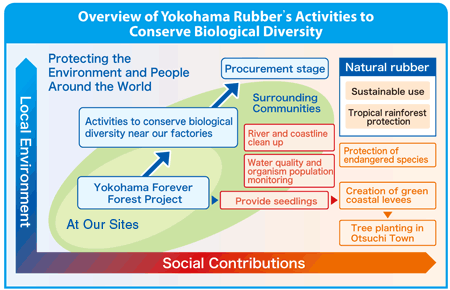
Steps of biodiversity activities
Yokohama Rubber’s biodiversity activities are implemented through the five steps of Step 0 to Step 4 that are described below. Ultimately, preservation activities and monitoring are conducted on an ongoing basis.
 Environment survey on areas surrounding production facilities
Environment survey on areas surrounding production facilities
In 2010, we used aerial photography from Google Maps to identify bodies of water (rivers, lakes and marshes, and seashores), vegetation areas, and environmental preservation area located near each of our business locations, and broadly classified these areas into three ranks. These surveys have already been completed for all production facilities.
The Mie Plant designated as Rank A according to this classification was first selected as a model plant, and the activities for Step 1 through Step 4 as follows were conducted in advance of other plants. We are currently gradually expanding these activities to include other plants to follow the Mie Plant.
Survey results
| Rank standard | Number of applicable business locations | |
|---|---|---|
| Rank A | Business locations adjacent to areas likely to have high biodiversity | (Five locations in Japan, two locations overseas) |
| Rank B | Business locations adjacent to areas with relatively important natural significance (forests, rivers, etc.) | (Three locations in Japan, two locations overseas) |
| Rank C | Business locations other than the above in urban area and industrial complexes | (Seven locations in Japan, eleven locations overseas) |
 Preliminary survey on areas surrounding production facilities
Preliminary survey on areas surrounding production facilities
We confirmed the actual natural environments surrounding production facilities, conducted first-hand observation and took actual measurements (electrical conductivity, transparency, and temperature) on the biota (birds, aquatic life, and vegetation) in these areas Normally, three to four locations are selected during this step.
 Main survey taking into consideration seasonal changes
Main survey taking into consideration seasonal changes
A biota survey is conducted on the locations selected in Step 1 for the four season of spring, summer, fall, and winter in which water quality is measured and seasonal changes are confirmed. Employees are able come in direct contact with nature through the observation that is conducted in the process of these activities, giving them an opportunity to consider the selection of applicable organisms and what kind of preservation is possible.
 Summarization through workshops
Summarization through workshops
Workshops are conducted by team. The observation results and water measurement data gathered from Step 2 are aggregated, analysis is conducted, and the areas subject to preservation are determined. After an annual activity plan is prepared, the contents are explained to the local residents, government bodies (city or town), and relevant NPO representatives in the areas surrounding production facilities so that they are provided with a sufficient understanding of the activities.
 Ongoing implementation of preservation activities and monitoring
Ongoing implementation of preservation activities and monitoring
Regular monitoring and preservation activities are conducted for the contents decided on during Step 3. Explanatory meetings are held one to two times per year with local residents, government bodies, and relevant NPO representatives to report on the status of activities. Feedback and opinions provided at these meetings are incorporated in the ongoing implementation of activities. If there are significant changes from the circumstances initially assumed while conducting activities during this step, the monitoring location and applicable organisms may be reviewed and changed according to the circumstances.
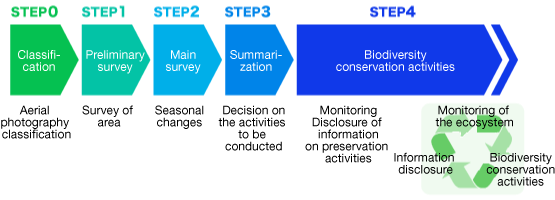
Progress status for FY 2013
Since April 2011, we have conducted surveys three times during early summer, summer, and fall in the midstream area of the Miya River, the downstream area of the Miya River, and the basin of the Hinokijiri River in the area surrounding the Mie Plant. Based on these results, we entered Step 4 in March 2012 and we have subsequently conducted activities every month.
During 2012, we conducted surveys three times at the Shinshiro Plant (including the Shinshiro Minami Plant) and the Mishima Plant as part of Step 2 to 3. During 2013, preservation activities and monitoring was conducted at the Mie Plant and the Shinshiro Plant (including the Shinshiro Minami Plant) for Step 4. While Step 2 was being implemented on an ongoing basis at the Mie Plant, surveys for Step 2 were also conducted at four production facilities in Onomichi, Ibaraki, Nagano, and Hiratsuka. In terms of overseas production facilities, preliminary surveys for Step 1 were conducted at two locations in Thailand (* YTMT and YTRC). Going forward, these two locations will be used as model plants for overseas production facilities.
Survey results
* Click on the names of the plants to see details on the activities being conducted at these locations.
| Mie Plant | Regular implementation of monitoring and preservation activities at three locations | |
|---|---|---|
| Shinshiro Plant | Regular implementation of monitoring at three locations and preservation activities at one location | |
| Mishima Plant | Monitoring and preservation activities at one location | |
| Onomichi Plant | Decision on the monitoring location and activities to be conducted | |
| Ibaraki Plant | Decision on the monitoring location and activities to be conducted | |
| Nagano Plant | Decision on the monitoring location and activities to be conducted | |
| Hiratsuka Factory | Monitoring at three locations | |
| YTMT* | Implementation of preliminary survey | |
| YTRC* | Implementation of preliminary survey |
* YTMT YOKOHAMA TIRE MANUFACTURING (THAILAND)
* YTRC Y.T. RUBBER CO.LTD.
Mie Plant 
Located in Ise City, Mie Prefecture, water intake is from the Miya River system, which is said to be one of the clearest river systems in Japan. Water is discharged into the Hinokijiri River, which is a tributary of the Isuzu River. We have conducted activities with the aim of reducing the impact on these two rivers and the surrounding wildlife at three locations near the plant through three teams.
Survey results
| Locations of activities | Relationship with Mie Plant | Purpose of activities | Main activities |
|---|---|---|---|
| Retarding basin at the plant premises | Discharge point |
|
Creating biotopes Aquatic life survey |
| Midstream of the Hinokijiri River | Discharge point |
|
Water quality survey Studying the number of Japanese killfish |
| Ominato sea coast (Facing the Ise Bay) |
Effluence sea area of the water intake and drainage area |
|
Survey on status of sandy beaches (the width and depth of sandy beaches, measurements of elements such as the diameter of sand grains) Studying the number of native seaside plants (vitex rotundifolia, glehnia littoralis, etc.) Removal of exotic plants (oenothera laciniata) Picking up trash and driftwood |
(1) Monitoring and preservation activities
1. Higashitoyohama Hinterlands Black Team representative
In the hinterlands in the downstream of the Miya River, we monitor wild birds with the aim of improving the abundance of local nature, and as part of these efforts, we have created our own wild birds catalog and observation map. Unfortunately, we have learned that preservation activities are limited here because this location is on private property, and the location of activities changes to a retarding basin on plant premises midway. The cooling water effluent for some facilities and rainwater are the main source of water for this retarding basin, and as there is inflow from agricultural water for neighboring fields, we are trying to develop this as a biotope.
-
wild birds survey in the hinterlands in the downstream of the Miya River
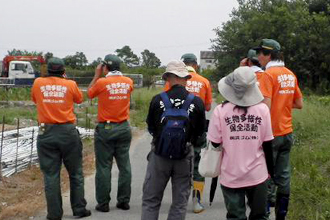
-
Biotope restoration activities in the land adjacent to the plant
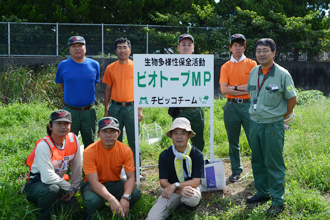
2. Hinokijiri River Kid's Team representative
In the midstream of the Hinokijiri River, in addition to surveying water quality, we also observe black killfish and flying dragonflies. It has been determined that water discharged from the plant has contributed to the purification of river water quality and that continuing to discharge water even when the plant is not operating has contributed to the prevention of fish dying from the lack of oxygen. By conducting monitoring activities including the creation of habitat distribution charts for black killfish we confirm the impact on the ecosystem where water is discharged.
-
Electrical conductivity measurement point
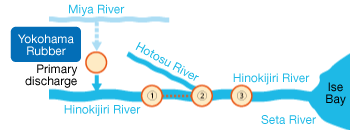
-
Electrical conductivity measurement results
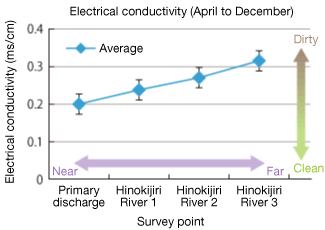
3. Ominato sea coast Noppo Team representative
The Ominato sea coast is the final exit of two rivers, the Miyagawa River and Isuzu River, facing the Ise Bay, and it is also the spawning ground of the loggerhead sea turtle that is specified as a class II endangered species. For this reason, we are conducting coastal cleaning activities, removing oenothera laciniata that is specified as an exotic plant requiring caution through exotic plant removal methods and working to protect native seaside plants such as glehnia littoralis, and making our own instruments for measuring the depth and hardness of the sandy beach in order to evaluate that status of the coast. Furthermore, as a form of extracurricular learning for Ominato Elementary School, we made a visit to provide a lesson for students in the fourth grade and removed oenothera laciniata together with them on October 4, 2013.
-
Removal of oenothera laciniata at the Ominato sea coast with the students of Ominato Elementary School
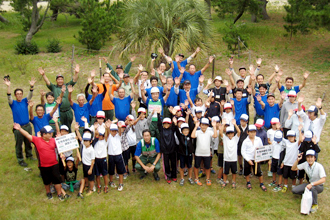
-
Making a sandy beach suitable for egg-laying by loggerhead sea turtles
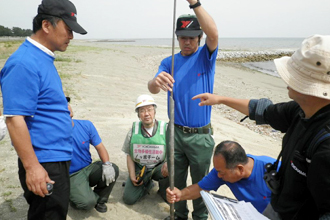
(2) Information disclosure and communication with localcommunities
1. Company-wide Biodiversity Conservation Debriefing Meeting
The first Biodiversity Conservation Debriefing Meeting was held at the Mie Plant on October 4, 2013 In this meeting attended by representatives of local offices in the Ise City area and government officials from Mie Prefecture and Ise City, Yokohama Rubber provided an explanation of its stance towards biodiversity conservation activities it has implemented up until now while presenting samples related to the activities it has implemented. Explanations were also provided by representatives of offices in areas away from the Mie Plant concerning the activities implemented in each region.
We received a variety of opinions from the participants and plan to incorporate these opinions into activities in the future.
2. Visiting lesson at Kuratayama Junior High School
We started providing visiting lessons on the theme of the environment for third-year students at the Kuratayama Junior High School in Ise City on December 6, 2013. We introduced various issues related to the global environment and the biodiversity conservation activities being implemented by Yokohama Rubber in Ise City, particularly activities focused on the Hinokijiri River that runs through the city. Everyone listened very enthusiastically.
-
The First Biodiversity Conservation Debriefing Meeting
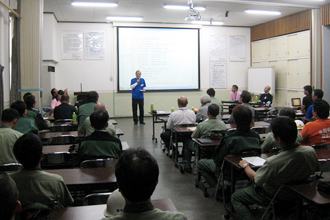
-
Visiting lesson at Kuratayama Junior High School
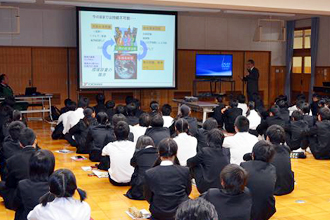
Shinshiro Plant, Shinshiro - Minami Plant 
The two plants located in Shinshiro, Aichi Prefecture uptake water from and discharge water to the Noda River and Kuroda River, which are tributaries of the Toyo River system. Based on an awareness of the benefits of the Toyo River system and for the purpose of minimizing the impact of our production activities, through three team we conducted monitoring and preservation activities eight times at three locations: on the Noda River and Kuroda River surrounding our business locations and at Yotsuya Senmaida in the upstream of the Toyo River system. Bird monitoring was conducted with the participation and guidance of members of the Toutoumi Wild Bird Society of Japan.
Locations of biodiversity conservation activities for FY 2013 and details of activities
| Locations of activities | Relationship with Shinshiro Plant | Purpose of activities | Main activities |
|---|---|---|---|
| Yotsuya Senmaida | Close to water source |
|
Investigation of water quality and aquatic organisms Cutting the grass |
| Midstream of the Noda River | Water intake and drainage area |
|
Investigation of water quality, aquatic organisms, and wild birds Cutting the grass |
| Midstream of the Kuroda River | Water intake and drainage area |
|
Investigation of water quality, aquatic organisms, and wild birds Cutting the grass |
(1) Monitoring and preservation activities
1. Yotsuya Senmaida
The grass is cut and monitoring of water quality and aquatic organisms is conducted at Yotsuya Senmaida. There have been 24 types of aquatic organisms confirmed, among which the rare lefua echigonia and Japanese fire belly newt (cynops pyrrhogaster) have been observed.
-
Lefua echigonia
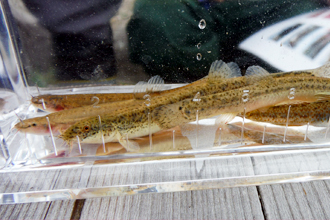
-
Japanese fire belly newt (cynops pyrrhogaster)
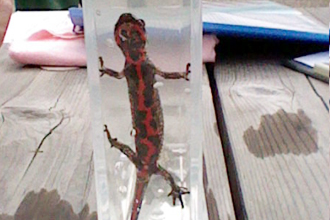
2. Noda River
Monitoring of water quality, aquatic organisms, and wild birds has been conducted at Yotsuya Senmaida. There have been 24 types of aquatic organisms and 33 types of wild birds confirmed here. There are rice paddies and forest near this area and visibility is good, and we have found that these make excellent environmental conditions for the feeding and roosting of wild birds.
Biodiversity survey at the Noda River
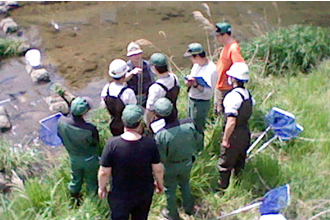
3. Kuroda River
The grass is cut and monitoring of water quality, aquatic organisms, and wild birds is conducted at the Kuroda River. There have been 28 types of aquatic organisms and 36 types of wild birds confirmed observed at the Kuroda River, and we have found that despite it being a small river it is inhabited by a wide variety of organisms. In terms of wild birds, a near-threatened species called the goshawk was observed in November.
-
Water quality study on the Kuroda River
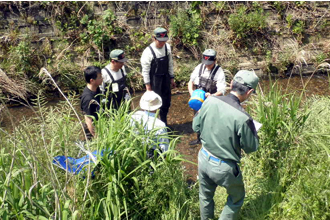
-
Wild birds observation on the Kuroda River
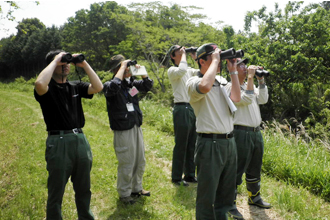
(2) Information disclosure and communication with local communities
The Shinshiro Plant has participated since the initial establishment of the Shinshiro and Shitara Ecosystem Network Council in October 2013 following the formulation of the Aichi Biodiversity Targets by 2020 by Aichi Prefecture, and at the Shitara Forum held in December 2013 a report was provided on the biodiversity conservation activities at the Shinshiro Plant and the YOKOHAMA Forever Forest project.
Activities announced at the Shinshiro and Shitara Ecosystem Network Council
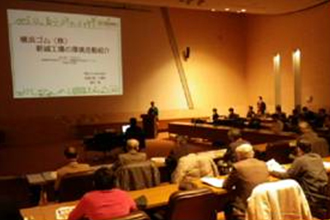
Mishima Plant 
(1) Monitoring, protection activities
Located in Mishima City, Shizuoka, the Mishima Plant draws well water for its operations and discharges waste water into the Goten River, a tributary of the Kano River. Spring water is found in abundance in Mishima City, it being noted for its particularly good quality. Based on our awareness as to the importance of reducing the impact of production activities, the Goten River was monitored (on water quality, aquatic life and flora) and cleaning activities also conducted. Moreover, in that kingfishers were observed nesting along the banks of the river, monitoring of nests was done 24-hours a day via remote cameras until the fledglings departed.
Locations of biodiversity conservation activities for FY 2013 and details of activities
| Locations of activities | Relationship with Mie Plant | Purpose of activities | Main activities |
|---|---|---|---|
| Goten River | Discharge point |
|
Investigation of aquatic organisms, investigation of vegetation, and river cleaning |
-
Water quality study on the Goten River
(before the drainage outlet)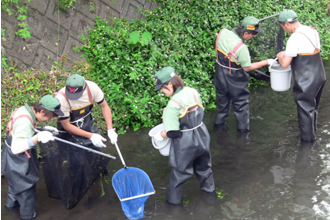
-
Kingfisher returning to dig a nest
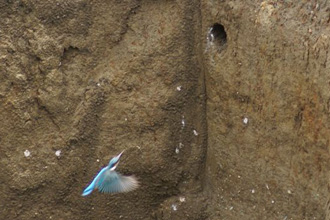
(2) Information disclosure and communication with local communities
We visited Mishima Environmental Policy Division on March 11, 2013 to provide an explanation on biodiversity activities. Subsequently at the regularly-held residents meeting on March 20 we provided a similar explanation on our biodiversity activities to residents of the local community. We provided information at what we have learned through surveys and presented materials indicating our future plans. We received a variety of opinions from the participating residents and plan to utilize these opinions into activities in the future.
Community explanatory meeting
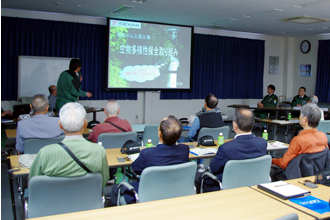
Onomichi Plant 
(1) Monitoring and preservation activities
The location is reclaimed land on the coast at the mouth of the Fujii River in Onomichi, Hiroshima Prefecture. Water for industrial use is reliant on waterworks provided by the city with the upstream of the Fujii River as the water source, and wastewater is all discharged to the sewage system. While there is no direct intake or discharge of water from the plant to the adjacent Fujii River, in consideration of the fact that production activities are dependent on local water resources, activities are conducted that aim at creating a river environment maintaining sufficient water quality and water quantity for sound water circulation as required for the sustainable use of these water resources. During 2013 monitoring of water quality, aquatic life, birds, and vegetation was conducted at Fujii River Shinsui Park and two locations on the plant premises. On the plant premises there are various dragonflies and other insects that like to inhabit waterfront areas; grasshoppers, crickets, and butterflies that like to inhabit grassy areas; and neptis philyra (type of butterfly) that like to inhabit forest areas. These areas have also been propagated by the wandering glider from Southeast Asia and the common darter that propagate marshes near the coast. As there is a rich variety of grassland, forest, and aquatic insects inhabiting a myriad of environments, we know that contributions have been made to the preservation of ecosystems in green areas on the plant premises. Bird monitoring was conducted with the participation and guidance of members of the Hiroshima Prefecture chapter of the Wild Bird Society of Japan.
-
Neptis philyra (type of butterfly)
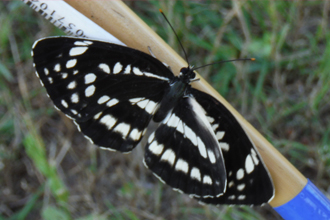
-
Wandering glider
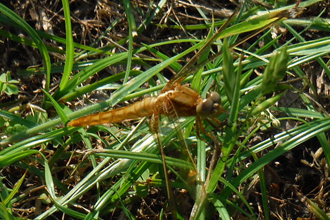
Insect collecting
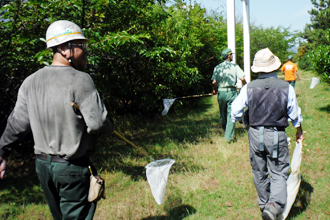
A workshop was conducted at the end of the year, and it was decided to conduct activities at Fujii River Shinsui Park and two locations at the plant premises from 2014 and onward. We will conduct monitoring of water quality, birds, aquatic life, and vegetation, river cleaning, and removal of introduced species at Fujii River Shinsui Park, while at the plant premises we will conduct monitoring of birds and insects and establish biotopes.
-
Workshop
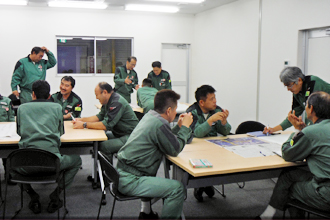
-
Summary of opinions
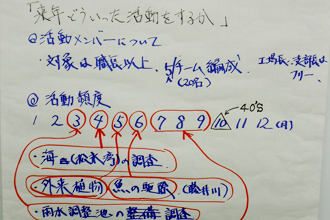
Locations of biodiversity conservation activities for FY 2013 and details of activities
| Locations of activities | Relationship with Onomichi Plant | Purpose of activities | Main activities |
|---|---|---|---|
| Fujii River Shinsui Park | Close to water source |
|
Survey of water quality, birds, aquatic life, and vegetation
River cleaning Removal of exotic species |
| Greening at the plant premises | Stormwater discharge point |
|
Creating biotopes Survey on birds and insects |
Ibaraki Plant 

(1) Monitoring and preservation activities
The plant is in Omitama, in the middle of broad rice fields on the Kanto Plain. Underground water is used for water intake, and while the amount of water used here is low compared to other plants, this water is essential for operations. Discharge water is discharged into the Sonobe River located approximately 800 meters from the plant. The downstream of the Sonobe River is connected to Lake Kasumigaura, and this water is used for agricultural purposes in rural zones in the area. We learned that during the busy farming season water is pumped up from Lake kasumigaura downstream to compensate for water shortages, and that there is a significant increase in water quantity. We implement environmental conservation activities by conducting monitoring to evaluate the soundness of the river. Monitoring of the Sonobe River was conducted three times during 2013 at three locations: the point of plant water discharge, as well as upstream and downstream from this point. Members of the local Omitama Seibutus no Kai and the Ibaraki Prefecture chapter of the Wild Bird Society of Japan participated as advisors while the project was underway. In terms of birds, it was discovered that the area was inhabited by shrike after observing waterfowl throughout the year. We also learned that in terms of aquatic organisms the area was inhabited by many exotic crayfish and pond loaches, and in terms of plants by many horseweeds, goldenrods, and rapes.
-
Capturing aquatic organisms
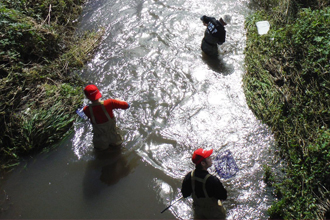
-
Wild birds observation
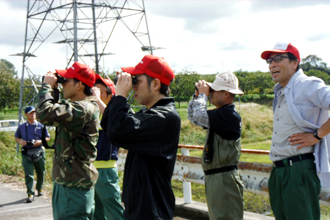
A workshop was held in October and was decided that monitoring of the Sonobe River basin would be conducted by three teams and that exotic species would be removed as a preservation activity.
Biodiversity conservation activity plan for FY2014
| Locations of activities | Relationship with Ibaraki Plant | Purpose of activities | Main activities |
|---|---|---|---|
| Main stream of the Sonobe River | Discharge point |
|
Survey of water quality, birds, aquatic life, and vegetation
Removal of exotic plants |
| Tributaries of the Sonobe River | Discharge point |
|
Survey of water quality, birds, aquatic life, and vegetation Removal of exotic species (crayfish) |
| Plant water discharge outlet on the Sonobe River | Stormwater discharge point |
|
Removal of exotic species (goldenrod) |
Nagano Plant 
(1) Monitoring and preservation activities
The plant is in Takamori Town, which is located approximately 20 minutes by car along the Tenryu River from Iida, Nagano Prefecture. There is also a warehouse in Toyooka, which is somewhat further away from the Tenryu River. The area surrounding the plant is full of orchards and fields, making it an area with an abundant natural environment. Underground water is used for water intake, and discharge water is purified and discharged as sewage. Note that rainwater is released to the Oshima River that is a tributary of the Tenryu River that flows nearby. Biodiversity conservation activities consist of monitoring of water quality, birds, aquatic life, and vegetation at three locations: the Oshima River, the confluence of the Tenryu River, and the tributary the Terasawa River. In the Tenryu River basin, exotic plants such as tickseed, black locust, ragweed, and bur cucumber have been observed, while in terms of aquatic organisms water insects (such as water stick insects and sphelocheirus vittatus) and amphibians that prefer healthy water have been observed. In addition, it was observed that despite it being a river basin there were few waterfowl and that there were many urban birds such as bulbuls, sparrows, and gray starlings. Bird monitoring was conducted with the participation and guidance of members of the Inadani chapter of the Wild Bird Society of Japan.
It was decided that a workshop would be held at the end of the year and that monitoring of the Tenryu River basin would be conducted by three teams at two locations and that exotic species would be removed as a preservation activity.
Biodiversity conservation activity plan for FY2014
| Locations of activities | Relationship with Nagano Plant | Purpose of activities | Main activities |
|---|---|---|---|
| Oshima River | Stormwater discharge point |
|
Survey of water quality, birds, aquatic life, and vegetation |
| Tenryu River (confluence with the Oshima River) | Stormwater discharge point |
|
Survey of water quality, birds, aquatic life, and vegetation |
| Terasawa River Shinsui Park | Discharge point for warehouse in Toyooka |
|
Survey of water quality, birds, aquatic life, and vegetation Removal of exotic species (goldenrod) |
-
Tickseed on the Oshima River
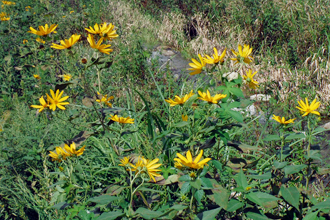
-
Bullfrog on the Tenryu River
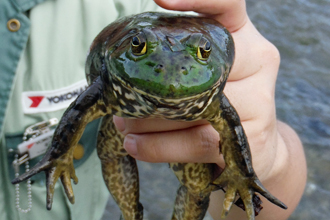
Macromia larvae on the Tenryu River
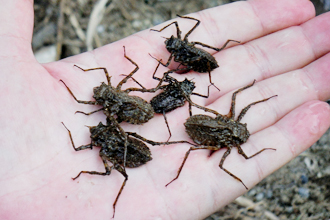
Hiratsuka Plant 

(1) Monitoring and preservation activities
The Hiratsuka Plant is located in Hiratsuka, Kanagawa Prefecture approximately 1km to the north of the train station in that city. This location is approximately one hour by train from the head office in Tokyo. This is a business location that combines product manufacturing processes and the R&D function, and a characteristic of this location that differentiates it from other business locations is that it is an aggregate of multiple offices. For this reason it was decided to let staff members experience monitoring surveys as a part of biodiversity initiatives. For this reason Step 2 would take a longer period of time than other business locations and it was decided that activities would be conducted by different staff members every time without forming fixed activity teams. The plant uses both underground water and city water, and discharge water is all discharged to public sewerage. Because the Kaname River basin is the intake point for underground water, a total of three locations were used as monitoring locations: two locations in the upstream of the Suzu River and one location in the midstream of the Kaname River. Birds, vegetation, aquatic life, and water quality were monitored at each of these locations. As a result of the monitoring it was observed that in terms of vegetation there were many exotic species such as giant ragweed and bur cucumber and that there had been a significant decrease in native species, that there was a relatively rich abundance of aquatic life, and that there was an abundance of birds, particularly waterfowl. A workshop was held and it was decided the exotic species would be pulled out and that the river banks would be cleaned during 2014. Furthermore, because the plant is close to Tokyo, there are plans to conduct training on biodiversity conservation activities for head office employees.
Biodiversity conservation activities for FY2014
| Locations of activities | Relationship with Hiratsuka Factory | Purpose of activities | Main activities |
|---|---|---|---|
| Suzu River (Miyashita Bridge) | Water intake area |
|
Survey of water quality, birds, aquatic life, and vegetation |
| Suzu River (Ohata Bridge) | Water intake area |
|
Survey of water quality, birds, aquatic life, and vegetation |
| Midstream of the Kaname River | Water intake area |
|
Survey of water quality, birds, aquatic life, and vegetation Elimination of exotic species (giant ragweed, bur cucumber) |
-
Measurements of transparency
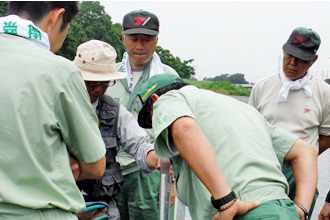
-
Bird observation
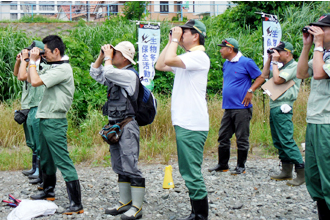
-
Japanese eel
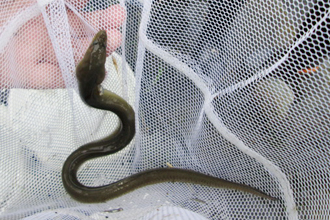
-
Japanese mitten crab
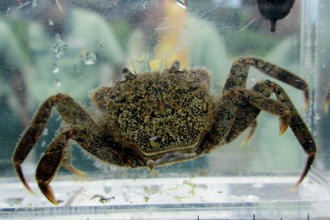
YTMT 
The plant is located within a large industrial complex in Rayong Province east of Bangkok, Thailand. Preliminary surveys for Step 0 were conducted during 2013. As a result, it was found that the plant was 100% dependent on the company managing the industrial complex for water intake and discharge, that it would be difficult to conduct activities focused on water, and that the natural environment on the premises was limited as the location was surrounded by factories. Many insects (dragonflies, butterflies) were observed on the premises and there are plans to conduct the main survey for Step 2 during FY 2014 to confirm the impact on the ecosystem found in green spaces on the premises. Because many overseas plants are located in areas similar to the location of YTMT, it was decided that this plant would serve as a model for biodiversity conservation activities for overseas plants.
-
Blackspot
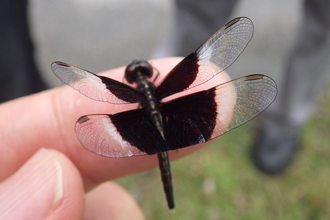
-
Common emigrant
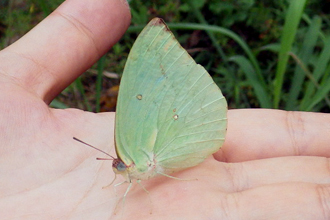
YTRC 
The plant is in Surat Thani in the south of Thailand, in an area surrounded by natural rubber plantations and palm plantations. The raw materials of natural rubber from rubber plantations is processed into bales here and subsequently delivered to tire plants. The Tapi River flows adjacent to the plant and supplies the water used by the plant. A closed system has been adopted for the use of this water in which water is cleaned through sedimentation in a settling reservoir on the premises after use for rubber cleaning and then used repeatedly as cleaning water. For this reason, there are multiple large settling reservoirs on the premises. Various insects and birds were observed at the edges of these reservoirs in the preliminary surveys conducted in 2013. In addition, it was confirmed that because water flows into these reservoirs from the Tapi River, various types of fish had entered the reservoirs. We will proceed to Step 2 in 2014.
-
Capturing fish with a net in a clean lake
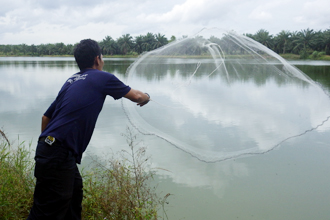
-
Capturing red cheek barb
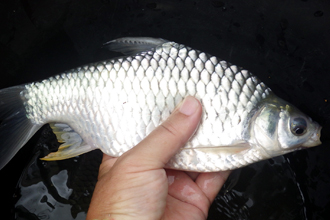
Biodiversity conservation activities in regions where natural rubber is produced
Biodiversity conservation activities in regions where natural rubber is produced
Yokohama Rubber conducts business activities that use natural resources, metals, and mineral resources such as natural rubber. Natural rubber, which is produced on plantations in South East Asia, is believed to have a particularly strong impact on the biodiversity of the region. Meanwhile, while the biodiversity of the South East Asia region where natural rubber is produced (Thailand, Malaysia, Indonesia, etc.) is abundant, because the regions that face the risk of destruction are mostly the same regions as biodiversity hotspots, consideration towards natural preservation is required in local development and procurement activities.
Particularly in Thailand from which we import large volumes of natural rubber, there are many small plantations, and from our position at the top of the supply chain it does not make it easy for us to contribute to the involvement of these small plantations with biodiversity preservation. However, as Yokohama Rubber operates a tire plant and natural rubber processing plant in Thailand, we would like to contribute to the preservation of biodiversity within the scope of our influence from a long-term and global perspective.
Biodiversity surveys and natural environment surveys on the natural rubber plantations near YTRC were conducted during 2013. As a result, we have come to realize that natural rubber plantations in Thailand could have a rich ecosystem like the natural woodlands that coexists with nearby populated areas in Japan. These surveys will be continued during 2014.